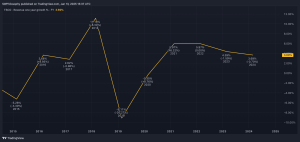Shares in JD Sports Fashion (LSE:JD.), the FTSE 100 retailer, have fluctuated wildly over the past four months. Unfortunately, this period of volatility has coincided with me taking a position.
In August, the stock was changing hands for around 130p. That’s when I first invested. Six weeks later, the share price had climbed to just under 160p. On 22 November, it slumped to 93p. Today (13 December), it’s around 102p.
This is particularly unusual for a FTSE 100 stock. The revenues and earnings of the UK’s largest listed companies are generally more reliable. This should mean fewer shocks for investors.
Non, je ne regrette rien!
But I don’t have buyer’s remorse. That’s because I take a long-term view with my investments. Although I admit it’s difficult, I try to ignore short-term price volatility.
A quality stock should consistently deliver earnings growth, helping to increase its market cap. And I continue to believe that JD Sports is a classy business.
Caught in the crossfire
But it’s unfortunate that investor sentiment towards the retailer has apparently suffered due to well-documented problems at Nike.
As the chart below shows, there’s a high degree of correlation between movements in the two stock prices.
This is probably not surprising given that it’s estimated that approximately 50% of JD Sport’s revenue comes from the sale of Nike’s products. Indeed, the British-based retailer describes itself as the American sportswear giant’s leading global partner.
But in the world of sports fashion, I believe there’s more to life than Nike.
As the table below shows, there are plenty of other successful brands out there, all of which are sold by JD Sports. I therefore think it’s a little unfair that the company’s share price has fallen nearly 20% since Nike issued its profits warning in June.
| Brand | Revenue 2023 ($bn) | 2020-2023 CAGR (%) |
|---|---|---|
| Nike | 51.2 | 9.4 |
| Adidas | 28.8 | 7.3 |
| VF Corporation (owner of Vans) | 13.8 | 6.7 |
| Puma | 8.6 | 6.1 |
| Skechers | 7.4 | 8.2 |
A healthy market
Despite this negativity, I’m encouraged by predictions for the sector.
In 2023, the global sportswear market was estimated to be worth $397bn. This is forecast to grow to $614bn by 2031, a compound annual growth rate of 5.6%.
If the British retailer could grow its earnings by this figure each year — it’s expecting an adjusted pre-tax profit of at least £955m this year — I’d be happy.
And I see no reason why this can’t happen.
Overseas expansion
In July, it acquired Hibbett (United States), which operates 1,169 stores. During the 53 weeks to 3 February 2024, it generated net sales of $1.73bn and reported a pre-tax profit of $132m.
Four months later, it bought Courir (France), with 362 shops in Western Europe and Africa. In 2023, it reported revenue of €726m and made a profit before interest and tax of €50m.
Although the company’s half-year (26 weeks to 3 August) results disappointed investors — its shares tanked 6.1% on 2 October — they only included 10 days of earnings from the Hibbett acquisition.
But the company’s dividend is miserly — the stock’s presently yielding less than 1%. And as Nike has recently demonstrated, it’s notoriously difficult to remain relevant in a fashion industry that’s highly competitive and has to respond rapidly to changing tastes.
However, despite these risks, I think the retailer’s diversification away from the UK is a good move. And although I’m currently sitting on a paper loss, I’m confident that — over the long term — the JD Sports share price will soon move upwards.
This post was originally published on Motley Fool







